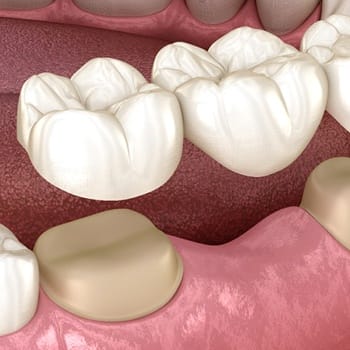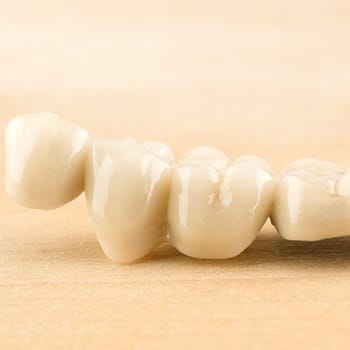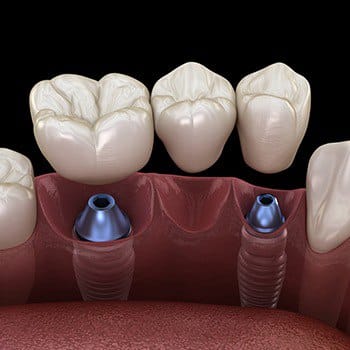Replacing One to Three Teeth
Do you find yourself not smiling or laughing as much as you used to thanks to a missing tooth? Filling this gap can be important for restoring your confidence as well as protecting your oral health. At Shwarts Family Dentistry, we can replace one to three teeth at once with dental bridges in Dallas, allowing you to chew and talk normally again while also making your smile whole again. Contact us today to learn more about this type of restoration and the difference it could make in your life.

Limited Time Special Offer
$500 off Accepted Invisalign Treatment
- Free Records plus…
- Take Home Teeth Whitening
…at treatment completion.
($1,300 Value)
Call 972-437-6035 or email us using this form to schedule an appointment or for more details!
Why Choose Shwarts Family Dentistry in Dallas for Dental Bridges?

WHAT IS A DENTAL BRIDGE?
A dental bridge consists of one or more false teeth called pontics, which lie in between two crowns. The pontics and crowns can be made up of many different materials, but we’ll typically use porcelain or similar ceramics because of how closely they can be made to resemble real teeth. Before you receive a dental bridge, we’ll remove a small amount of enamel from the teeth on either side of the gap; this creates enough room for the crowns to be placed on top. Your natural teeth will give your dental bridge the support it needs for biting and chewing.
WHO IS A GOOD CANDIDATE FOR A DENTAL BRIDGE?
A dental bridge may be a good option for anyone who is missing up to three consecutive teeth. Of course, before you can get a bridge, your remaining teeth will need to be strong and healthy in order to support it. Also, if you have gum disease, it needs to be treated before your bridge can be placed.
If you’re considering a bridge retained by dental implants, we’ll need to make sure your jawbone has enough density for a successful surgery. Lost density can be regained with a bone grafting procedure.


BENEFITS OF A DENTAL BRIDGE
- Beautiful Smile: You can get rid of the gap in your grin using a natural-looking prosthetic that will blend in with the rest of your natural teeth.
- A Healthier Bite: Replacing your missing tooth will ensure that the forces of your bite will continue to be distributed correctly so that they don’t wear down as quickly.
- Hold Your Teeth in Place: Teeth tend to shift when one is missing, but you can avoid such complications by holding them in place with a bridge.
BRIDGES AND DENTAL IMPLANTS
If you don’t want to make changes to your remaining healthy teeth, there’s a way you can get a dental bridge while also preserving your enamel. We can place two dental implant posts into your jaw that can serve as the “roots” for your false teeth. In many cases, this is the healthier alternative; not only does it avoid weakening your natural teeth, but it strengthens your jawbone by preventing or reversing the bone loss that occurs once you’ve lost a tooth.


DENTAL BRIDGE FAQS
A dental bridge can serve as a reliable and long-lasting tooth replacement. Before you contact us to schedule your restorative consultation, though, you might want to know more about this treatment and what you can expect from it. That is why we have put together the following list of dental bridges FAQs in Dallas, along with their answers. If you don’t see the information you were hoping for, please give us a call. We look forward to speaking with you!
A traditional bridge has a crown on each end with 1 – 3 pontics between them. However, there are a few other types of bridges, including:
- Cantilever bridges. A cantilever bridge has a crown on just one end. This type of restoration may be used in places where there are not abutment teeth on both sides of a gap that can support crowns.
- Maryland bonded bridge. This type of restoration is bonded to the abutment teeth with a strong resin. Unlike a traditional bridge, it does not require that the abutment teeth be modified. Maryland bonded bridges are often used to replace front teeth.
As always, oral hygiene is extremely important. You should be sure to brush along your gumline to reduce the risk that bacteria will sneak beneath your bridge and damage your abutment teeth. Flossing is also key. Although you cannot floss between your bridge’s crowns and pontics, you can and should floss beneath your pontics. A floss threader can help you do so. You might also consider investing in a water flosser (otherwise called an oral irrigator or Waterpik) to clean beneath the bridge.
Bridges are strong enough to handle virtually any food. However, you should be cautious with anything that is extremely hard because such foods might damage your restoration.
It is normal for a bridge to last for well over 10 years. Of course, your restoration’s lifespan will depend on a number of factors. If you grind your teeth or are not diligent about oral hygiene, your bridge might fail earlier than expected. Other factors, such as dental trauma or damage to your abutment teeth, could also adversely affect how long your bridge lasts.
In most cases, at least two appointments are required to design and place a traditional dental bridge. At the first appointment, your abutment teeth will be prepared. This involves removing some of their enamel so they fit well beneath their crowns. Our team will take impressions of your mouth and use those to design your bridge. In the meantime, you’ll wear a temporary restoration to protect your abutment teeth. After a laboratory creates your bridge, we will verify its fit before we cement it onto your teeth.
We strive to make the treatment process as comfortable and conservative as possible. Although your abutment teeth may be a bit sensitive after you receive a bridge, you should be feeling quite normal relatively soon after treatment.

